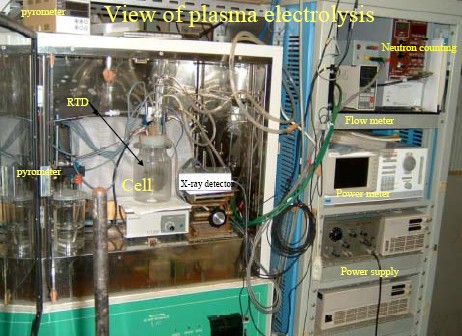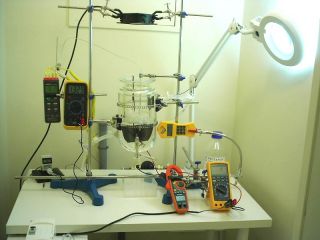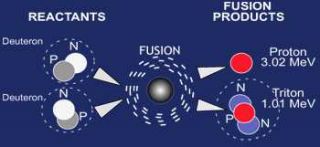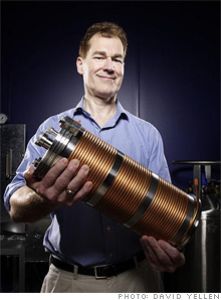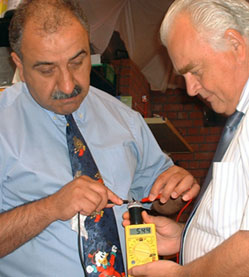Battery Powered Homes
Consumers are producers in bold new
distributed network

TRANSCRIPT
NARRATION
There's a power revolution heading for our homes, a device that allows you to take power into your own hands, and is predicted to change our world. It's batteries, home batteries, and within five years, over a million Australian homes are expected to have one.
Dr Jonica Newby
This is what a lithium-ion home battery looks like. It may be an unfamiliar sight now, but not for long, as retailers start jostling to sign you up to their deal.
Dr Jonica Newby
Home batteries are really the holy grail of renewables and the transition away from fossil fuels.
Kobad Bhavnagri
If energy companies ignore them, they will watch their businesses crumbling in front of them.
Ivor Frischknechti
Australia's at the global vanguard here. We're going first.
NARRATION
So what do you need to know about this disruptive technology, a technology that offers every home the potential for 24-hour renewable power? And let's start by finding out why you might want one. This is Josh Byrne, already known to many ABC viewers as a presenter on Gardening Australia. And this is Josh's house.
Dr Jonica Newby
This is absolutely gorgeous.
Josh Byrne
Thank you.
NARRATION
As a keen environmental scientist, Josh built this place back in 2013 to be both affordable and super efficient.
Josh Byrne
So, we've got state-of-the-art water systems, with solar hot water, then three kilowatts of solar panels on the roof.
NARRATION
But there was a problem. Even though his house was already producing twice as much energy as it used, Josh wasn't getting the benefit.
Dr Jonica Newby
So you're pumping all this energy into the grid and you're being paid how much for it?
Josh Byrne
About seven cents a kilowatt hour.
Dr Jonica Newby
Right. And at night, how much to you pay?
Josh Byrne
We're buying it back at four times that price.
Dr Jonica Newby
Four times. That doesn't seem fair, Josh.
Josh Byrne
Not really, no.
NARRATION
With the state-of-the-art monitoring equipment Josh installed, sustainability expert Jemma Green has followed the situation carefully.
Jemma Green
I'll show you where the problem is. Basically, 60% of Josh's household electricity is at night-time. So even though the solar panels are generating 76% more power than he needs, he's still very reliant on the grids and also getting quite a big bill as a result.
Josh Byrne
So, bring on the battery.
Dr Jonica Newby
(Laughs) I bet you were hanging out for that to arrive.
NARRATION
About six months ago, Josh took delivery of the battery he'd been waiting for.
Josh Byrne
Hey-hey!
NARRATION
And now, we finally get to see it.
Josh Byrne
These are the batteries in here.
Dr Jonica Newby
Yep.
Josh Byrne
This has eight kilowatt hours of usable stored power.
Dr Jonica Newby
It's not just a battery.
Josh Byrne
No, the system is always more than just the battery. There's also an inverter, which helps makes the power into a usable form for the house, but then there's also, very importantly, an energy management system, which is the controls of the system. And all of that can be displayed on a little display like this.
NARRATION
The management software tells your entire system when to flow electricity where. For example, on a sunny day, when generation exceeds use, the power will go first to recharge the battery, and then any excess can be delivered to the grid. At night, when Josh's family is on maximum power use, the power flow goes back to the house.
Dr Jonica Newby
OK, so you've had the battery for a month. How's it gone?
Jemma Green
Well, it's quite amazing what the battery's done. Basically, 53% of the household's electricity needs are now coming from the battery. 44% is still coming from their solar panel during the day, and only 3% from the grid. So it's a really dramatic shift.
Dr Jonica Newby
So that's virtually 24-hour renewable power.
Josh Byrne
Yeah, right there.
Dr Jonica Newby
You've done it!
Josh Byrne
Thank you. Well done, Jemma, too.
NARRATION
So why a home battery revolution now? Well, to understand that, let's rewind the battery clock back a bit. Remember these? The first mobile phones, unaffectionately known as The Brick, used nickel-cadmium batteries, which were really bulky. But lithium-ion batteries were about to set the phone free. So what's so special about lithium? Well, at an atomic level, lithium is the lightest metal. So, if it can be made into a battery, it will be light and hold a lot of charge for its size. And crucially for battery chemistry, lithium easily loses an electron to become a positively charged ion.
Dr Jonica Newby
So this is the basic principle of the rechargeable lithium-ion battery. On the negative side you have a carbon electrode, plus lithium. On the positive side you have a metal oxide. Now, when the battery is being used, an electron is pulled out from here. To balance the charge out, the lithium ion now travels across to here. And when all the lithium ions have moved across, your battery is out of charge. So, to recharge the battery, simply reverse the process, the lithium ions swing back.
NARRATION
Lithium batteries were first invented in the 1980s, but early versions had an unfortunate tendency to self-combust. So scientists fiddled with the chemistry, adding carbon for improved safety and trying different kinds of metal oxide.
Dr Jonica Newby
And the formulation that made our world take off was lithium cobalt oxide.
NARRATION
Our phones, our computers, modern life runs on lithium batteries. But there was one more step to making a battery for your home that was safe and affordable. It was this - the leap into electric cars. When they were first being designed, there were further fears that in that super-heated environment, lithium batteries were still a fire risk. So companies went back to the chemistry board to find other metal oxides, and batteries got even safer. All of a sudden, huge factories sprung up to churn out batteries for electric cars. And once they were being mass-produced, thoughts turned to another market - homes - and those are the batteries that are coming on stream now, with many companies deciding to launch first in Australia.
Dr Jonica Newby
Here, in Australia, we have a unique confluence. We are a place with a lot of sunshine, we are a tech-savvy community, we have high electricity costs, we have a population really wanting this change, and the world is watching.
NARRATION
So what do these new batteries mean for us? Are we all going to end up going off-grid? Well, no. Most experts see three main scenarios, and we've asked some early adopters to show us what they're doing. Option one is going off-grid altogether. This will appeal to many of us. To remote property owners where, even with lead-acid batteries, it's already cheaper, often than grid connection.
Mr Sharp
This is where our 12-volt battery system lives, and this is also where our blue-tongued lizard lives.
NARRATION
But it will also appeal to those who are just annoyed with energy companies and want to be done with them.
Michael Mobbs
Look at this. It's off my house. It used to connect to the grid. It's my trophy. (Chuckles)
NARRATION
The disadvantage, though, is to go off-grid completely, you need to buy a big enough battery for a cloudy week without sunshine. Option two is virtually off-grid, where you generate most of your own power, but keep the wire for backup.
Josh Byrne
We decided to stay grid-connected for two main reasons. Firstly, we wanted the backup of the grid, should we need it. But also, on most days we're generating surplus solar power and we don't want to waste it. So we want to push it out to the grid so others can use it.
NARRATION
Option three, well, this is where the experts see most of us going in the near future. It's installing a smaller battery to use your solar at night and avoid peak pricing.
Mrs McConnell
This is our battery. It's a 6.4 kilowatt LG. The sun is going down and you can see we're starting to draw from the battery, and we're also drawing a little bit from the grid.
NARRATION
The average family uses 20 to 40 kilowatts of energy a day, and for most, the peak time is early evening. If you switch to what's called a 'time of use tariff', which many energy retailers now offer, then you can use your battery during the peak hours when electricity is expensive.
Mrs McConnell
We've noticed that the peak comes on at 2pm and finishes at 8pm. So if it's sunny, the battery will get us through to the end of peak.
Jemma Green
So you're likely to see households put small batteries systems in at first, just to deal with the peak pricing period. And then as battery prices come down, perhaps upsize their battery systems when the payback period is more attractive. It's very much a modular system, so you can start with three kilowatt hours and move up six kilowatt hours. You can have a massive power station at the end if you want.
NARRATION
So, bottom line, how much will it cost?
Dr Jonica Newby
Well, up until early 2015, you couldn't get a seven kilowatt battery plus inverter, plus installation, for under about $15,000. But in the last six months, prices have suddenly dropped by a third or even more.
NARRATION
Energy company AGL is now offering a battery and inverter package for under $10,000.
Marc England
To be honest, that's subsidised. We've done that because we want to get batteries out into the market.
NARRATION
Other companies, including the much-hyped Tesla, are jostling around that price, while Ergon is trialling a leasing program.
Ian McLeod
So, Ergon is paying for the up-front cost of the solar PV and the batteries. It's a power-purchasing agreement.
NARRATION
And the cost will drop further with time.
Kobad Bhavnagri
We think the uptake of batteries will be slow to start, and mainly concentrated to technology enthusiasts. But by 2020, prices will have come down and grid-supplied energy charges will have gone up to the point where batteries really start to become mainstream.
NARRATION
Well, maybe, but this thing could take off faster, especially if you live in South Australia. In June 2015, the Adelaide Council announced up to a $5,000 rebate for homes and offices with batteries. So far, we've only talked about what a battery can do for your home. But there is a bigger picture here, a much bigger picture.
Dr Jonica Newby
You can become a part of the master controlling system that is our national grid, and earn a few extra quid on the side.
NARRATION
Meet the Manning family. They are the first family in the country to go live with an exciting new system being developed by Australian start-up software company Reposit Power. And they have a particularly Australian reason for wanting a battery.
Geoff Manning
Bushfire is a problem, so, yes, if we have a bushfire, we lose our power. And with no power, no pumps, no water, we can't fight a fire. So the battery was absolutely a critical addition to the house.
NARRATION
But this battery, with its souped-up software, is going to do a great deal more than fight the fire for them. It's designed to make money for them.
Luke Osborne
What we've done is equip Geoff's storage system with a smart brain, and what it does is it acts in Geoff's best financial interests.
NARRATION
Like other systems, it shows you clearly what's being generated, consumed and stored. Though this smart software actually helps run all that cost-effectively for you.
Luke Osborne
So we can see how much they've spent today, just 47 cents.
NARRATION
But it's also equipped with an extra-special superpower. It's hooked in to the wholesale price of the national electricity market, and every now and again, you will see this happen.
Dr Jonica Newby
Five cents!
Geoff Manning
Wow.
Dr Jonica Newby
You've earned five cents, Geoff! (Laughs)
NARRATION
Geoff's battery has been called upon to help save the grid.
Luke Osborne
On Geoff's grid dial, we can see that it's exporting hard out onto the grid. We can see that he's earning money here.
NARRATION
To understand what's happening, you need to know a little more about the extraordinary superstructure that is our grid. Australia has three major electricity grids - one in WA, one in the Northern Territory, and then the big daddy, our eastern seaboard grid, the largest interconnected power system in the world. And it's a hell of a complex job to manage it.
Dr Jonica Newby
When I first started thinking about the grid, I assumed that all the power that got generated by, say, coal or gas got stored somewhere and then we just used it as we needed it. But that's not how our grid works at all. In fact, there's very little electricity storage. Demand is met by literally turning up or down our power stations as we turn on or off our lights, and we have to get it exactly right on a minute-by-minute basis. Not enough power, blackout. Too much power and our power poles would blow up. Well, of course, actually, the safety mechanisms kick in, so blackout.
NARRATION
And how does this vast network keep exact pace with our lives? Well, it's a complex interaction between power generators and grid operators, like this one. And it all works via the National Electricity Market, or NEM.
Dr Darren Spoor
The more electricity people use, the more expensive it can get.
NARRATION
The NEM is the wholesale price for electricity and it goes up or down, depending on demand. Right now, everything is in balance, but what if our energy use suddenly spikes? Well, there are only a couple of types of power plant that can respond quickly enough to prevent a blackout - the Snowy Hydro Scheme and gas-fired plants. They can turn up the tap and churn out more power instantly, and they get paid a special premium for it. And this is where the Reposit software is so clever. It means if you have a battery, you can be part of that solution and get paid for it.
Dr Jonica Newby
Imagine it's the first big heatwave of the summer. Melbourne and Sydney wake up, then Brisbane, Adelaide, everyone's switching on their air-conditioners. 'Quick, we need more power now.' The price shoots up. Cue the gas-fired power stations, cue the Snowy Hydro, cue the Manning house. You've made $1.57. Whoo-hoo, jackpot!
Geoff Manning
Didn't even do anything!
NARRATION
Of course, individuals can't bid into this wholesale market directly, but their power company, Diamond Energy, is using their battery power and has agreed to pay the Mannings accordingly. And while their Reposit software is currently out in front, other similar models will follow in time. And there's a lot more to it than fun. Battery storage can help manage one of the key ingredients of the switch to renewable power. As more renewables come into the system, that influx of intermittent power makes grid management ever more complex.
Ivor Frischknechti
South Australia has actually had days where the entire state produces more renewable energy, more wind, than people are using. And so the only alternative is to export into Victoria. But let's imagine that that were happening for the whole of Australia, or for the whole of the network, there is no place to export to, other than batteries.
NARRATION
This is one of the reasons the South Australian government is subsidising batteries. Batteries and other forms of storage are the missing link. They can smooth out the grid, store excess power and rapidly release power when needed. This is why batteries are predicted to change our world. This is part of the revolution that will see renewable power become 24-hour power.
Luke Osborne
So 1.4 million households in Australia have solar panels at the moment. If we add batteries to those households, they, together, will make up the biggest power station in our system.
Marc England
That's a fundamental game changer in our industry.
Dr Jonica Newby
We always used to be told by the people who were the experts that solar is good, wind is good, but it's not base load power. Well, we now have base load power with the battery revolution. It's as simple as that.
Dr Jonica Newby
But what if you don't live in a freestanding home? Currently, about 15% of us live in apartments or other kinds of strata housing. And that's only set to rise.
NARRATION
So can we scale this technology up to an apartment? or even a whole suburb? I'm heading west now, to Perth which, with its sun-drenched landscape, now boasts an astonishing one in five households with solar panels. And WA's government now expects the majority of Perth's daytime electricity needs to be met by solar within ten years. But at the moment, strata dwellers are largely locked out of this home renewable revolution.
Jemma Green
Investors are reluctant to put in renewable energy technology because it's the tenant that gets the benefit. So we've got 1.4 million houses in Australia with rooftop solar, but hardly any in strata.
NARRATION
But this is the development Jemma Green expects will change that for good.
Man
The apartments will be on that side in the corner, this is where the maisonettes will be going, in this area here.
NARRATION
This is White Gum Valley, what will be an attractive multi-dwelling block near the highly-desirable postcode of Fremantle. And this is the site of what they've dubbed the Gen-Y building.
Jemma Green
This is super exciting because it's Australia's first solar and battery trial on strata.
NARRATION
The building comprises three apartments, with a central battery depot. What's groundbreaking is not so much the technology, it's that Jemma has developed a governance model where, for the first time, the strata owners become the main energy supplier to the tenant.
Jemma Green
And so they've got 24-hour renewable power, low-carbon electricity and also it provides a revenue stream for investors because the tenants pay their electricity bill to the strata company instead of paying it to the utility.
Dr Jonica Newby
That's incredible. That's like a potential game changer.
Jemma Green
I hope so. Yeah, I hope we'll see many of these pop up around Australia as a result of this research project.
NARRATION
But what about scaling it up again to the development of an entire suburb?
Dr Jonica Newby
This is the Alkimos Beach development just north of Perth. It was started in 2012, and by the time it's finished in 2020, it'll have 6,000 homes, parks, schools, shops, a town centre and, as you can see, every single home has solar.
NARRATION
And with a development this size, you might go for a bigger battery, a much bigger battery. This is the mega battery now being built for Alkimos Beach.
Man
There's 1.2 megawatt hours of energy storage here. To put that into a general term, this space here is equivalent to about a thousand wild horses packed into this area.
NARRATION
And that's enough to power a hundred households for a full day. These larger scale lithium batteries are already starting to be deployed in remote off-grid communities, But Alkimos Beach represents the first time community-level lithium battery storage will be tried in an urban residential development.
Nathan Ling
So, this is where the battery device is going to go.
NARRATION
Residents take advantage of the community battery via grid credits. Any excess solar power they export to the grid during the day becomes a credit they can then use at night. So residents benefit, but so does the developer, because with local energy storage, they may not need to build such a big grid connection to the development, potentially saving hundreds of thousands of dollars.
Ivor Frischknechti
To give you a sense of these infrastructure costs, they can easily be in the order of $10,000 or $20,000 per home. That cost could be invested in a combination of solar plus battery storage. So you make your connection costs cheaper, but then also have savings in an ongoing way because your energy bill is less.
NARRATION
It shows clearly how, in the future, batteries can reduce our spend on poles and wires.
Dr Jonica Newby
But what if there's a sudden game changer, a leap in battery technology itself? Well, then this disruptive technology goes on steroids.
NARRATION
Around the world, the race has been on to develop a better battery than the current lithium configuration. And some of the top contenders are right here in Australia, such as Professor Thomas Maschmeyer. He believes he's just invented the battery that will change everything.
Professor Thomas Maschmeyer
This is our battery, it's based on zinc bromide. So, we've got the two electrodes here and what's called a coin cell, and then the key part is that we have a gel that we put on top of the electrode.
NARRATION
Zinc-bromine flow batteries exist already. They use a liquid to transport the changed particles, which has its advantages, but they're too big to fit in a phone or computer. Thomas' breakthrough idea was to take a zinc-bromine battery, but instead of a liquid, use a gel. So why a gel? Well, it's neither a liquid nor a solid, but you get the advantages of both. And that includes being able to move ions quickly, so you get rapid charging.
Dr Jonica Newby
So how quickly does it charge?
Professor Thomas Maschmeyer
We can get it down to just a few minutes.
Dr Jonica Newby
Really? So you're saying I could charge my phone in just a few minutes.
Professor Thomas Maschmeyer
In just a few minutes. And not just your phone, but also your car.
NARRATION
Already the batter is running at 90% efficiency, which is higher than in your mobile phone. It has a longer lifetime and zinc is cheaper than lithium.
Dr Jonica Newby
So if this becomes commercialised, it's cheaper, you can charge it faster, it lasts longer...
Professor Thomas Maschmeyer
And the gel is made out of a fire-retardant material.
Dr Jonica Newby
It's fire-retardant as well?
Professor Thomas Maschmeyer
That's correct.
Dr Jonica Newby
That's pretty impressive.
Professor Thomas Maschmeyer
Well, thank you very much.
NARRATION
But perhaps its biggest potential lies in the fact that being a gel, it's bendy. It won't crack. And that's what excites this industry. The potential is for flat pack zinc-bromine batteries to be included in the very fabric of buildings. Lendlease is just one of the big companies that's been inspired by Professor Maschmeyer's vision.
Steve McCann
It's very exciting, his work. Our vision is to create the best places. To do that, you have to continue to innovate. And we're thinking about things like working with Professor Maschmeyer to use prefabricated wall segments, for example, as, effectively, battery storage or power storage facilities. So imagine that in a large scale and the impact that will have on the emissions from the built space, which is a very significant impact on the environment.
Dr Jonica Newby
Wow. So the very walls of your future buildings would have, or could have, these kinds of batteries inside them.
Steve McCann
We don't think that's too far away, actually.
Dr Jonica Newby
Really?!
Steve McCann
We do.
NARRATION
Well, as we all know, the trip from benchtop to big business is not a smooth one, and who can predict if it's Professor Maschmeyer's battery that will make the trip.
Dr Jonica Newby
But here we have a view of the future, a view big companies like this are taking seriously. You'd have to think, out of all the research groups around the world focussing on batteries, someone somewhere will make the breakthrough within the next 10 to 20 years. Maybe sooner.
Kobad Bhavnagri
One thing that history clearly tells us is that people like me and forecasters and also people in the business community tend to get their projections of how quickly things change wrong and wrong in one direction. They underestimate the pace of change.
NARRATION
But all that is well ahead of us. This is where we are now - the first bloom of the early adopters, as they sort out the glitches and show us the way to a future you now feel you can almost touch. Batteries are the thing that will eventually help bring on the ultimate transition to 24-hour renewable power.
Dr Jonica Newby
We all know fossil fuels have got to go, and this is a way of you and your family being able to contribute to that, or your business or your local community, and it is a way of contributing to a future that everybody will look back and say, 'Yes, I was in there first!'

- Reporter: Dr Jonica Newby
- Producer: Dr Jonica Newby
- Researcher: Dominique Pile
- Camera: Kevin May
Daniel Shaw
David Collins
Tim Kennedy
Julian Robin
Matt Robert - Sound: Steve Ravich
Adam Toole
Gavin Marsh
Adam Kennedy
Richard Glover
Martin Harrington
Shaun Kingman - Editor: Vaughan Smith
Story Contacts
Josh ByrneEnvironmental Scientist
Research fellow, Curtin University
Professor Peter Newman
Curtin University Sustainability Policy Institute
Jemma Green
Curtin University Sustainability Policy Institute
Marc England
Executive General Manager,
AGL New Energy
Ian McLeod
Chief Executive
Ergon Energy
Kobad Bhavnagri
Head of Australia
Bloomberg New Energy Finance
Luke Osborne
Director, Reposit Power
Dr Darren Spoor
Control Centre Management Transgrid
Ivor Frischknecht
CEO Australian Renewable Energy Agency
Nathan Ling
Synergy
Related Info
Australia's answer to Tesla: Indigenous firm AllGrid shines in solar battery industry
Cosmos Magazine : Batteries – A guide to the future.
Energy companies embracing domestic solar and storage systems in scramble to protect profits
Australian Renewable Energy Association.
Australian Energy Market Commission
Ergon: Manage your energy storage
Red Energy/Panasonic Trial
Alternative Technology Association.
Nature Magazine : The Rechargeable Revolution.
Powerwall: Solar energy storage batteries 'set to transform Australian electricity industry'
Home battery storage to 'revolutionise' solar industry in Australia: Climate Council report
CSIRO ultrabattery development
From Catalyst/ABC
@ http://www.abc.net.au/catalyst/stories/4398364.htm
For more information about clean electricity see http://nexusilluminati.blogspot.com/search/label/clean%20electricity
For more information solutions see http://nexusilluminati.blogspot.com/search/label/solutions
- Scroll down
through ‘Older Posts’ at the end of each section
Hope you like this
not for profit site -
It takes hours of work every day by
a genuinely incapacitated invalid to maintain, write, edit, research,
illustrate and publish this website from a tiny cabin in a remote forest
Like what we do? Please give anything
you can -
Contribute any amount and receive at
least one New Illuminati eBook!
(You can use a card
securely if you don’t use Paypal)
Please click below -
Spare Bitcoin
change?
Xtra Images – http://cdn2.yourstory.com/wp-content/uploads/2015/05/yourstory_solar_haryana.jpg
Video - https://youtu.be/7j_nMn5RYPM
For further enlightening
information enter a word or phrase into the random synchronistic search box @
the top left of http://nexusilluminati.blogspot.com
And see
New Illuminati – http://nexusilluminati.blogspot.com
New Illuminati on Facebook - https://www.facebook.com/the.new.illuminati
New Illuminati Youtube Channel - https://www.youtube.com/user/newilluminati/playlists
New Illuminati’s OWN Youtube Videos
-
New Illuminati on Google+ @ For
New Illuminati posts - https://plus.google.com/u/0/+RamAyana0/posts
New Illuminati on Twitter @ www.twitter.com/new_illuminati
New Illuminations –Art(icles) by
R. Ayana @ http://newilluminations.blogspot.com
The Her(m)etic Hermit - http://hermetic.blog.com
DISGRUNTLED SITE ADMINS PLEASE NOTE –
We provide
a live link to your original material on your site (and links via social
networking services) - which raises your ranking on search engines and helps
spread your info further!
This site
is published under Creative Commons (Attribution) CopyRIGHT (unless an
individual article or other item is declared otherwise by the copyright
holder). Reproduction for non-profit use is permitted & encouraged - if you
give attribution to the work & author and include all links in the original
(along with this or a similar notice).
Feel free
to make non-commercial hard (printed) or software copies or mirror sites - you
never know how long something will stay glued to the web – but remember
attribution!
If you
like what you see, please send a donation (no amount is too small or too large)
or leave a comment – and thanks for reading this far…
Live long
and prosper! Together we can create the best of all possible worlds…
From the New Illuminati – http://nexusilluminati.blogspot.com


